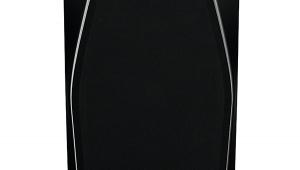Kef Reference 5 (£10,500 £11,500)

The 125mm/25mm driver developed for this new range is the 11th generation of KEF’s Uni-Q designs, while the four 6.5in bass units are placed as close as possible to this midrange/treble unit to minimise lobeing and interference dips at the crossover point.
But rather than having a conventional cone, the bass diaphragm is a shallow aluminium disc, which gives the driver a lower profile and ensures a minimal effect on the frequency response of the midrange and tweeter. Connecting the back of this diaphragm to the very large-diameter voice coil is a vented coupler, an innovation first developed for KEF’s iconic Blade.
As you’d expect, the Reference 5 speakers are massively constructed, and they come with heavy steel platforms with outrigger mountings for the spiked feet.
Internally, the cabinet is comprehensively braced. The actual drivers are braced by the internal structure but connected to it via a lossy damping material. Similarly, the front baffle is in aluminium laminated with resin, connected resiliently to the high-density wood cabinet using high-loss pads.
The Reference 5 is bass-reflex loaded by two rear ports, but KEF provides a choice between two bass tunings. Four heavy-duty chromed terminals provide for bi-wiring, with ‘taps’ in between to make or break the internal links that allow for single wiring. Standard finishes for the Reference series are Piano Black, Satin American Walnut and Gloss Rosewood, however there are also two special White and Black Kent Engineering and Foundry Edition finishes for the Reference 5.
Disappearing act
Once set up, the Reference 5s have a pleasing and thoroughly harmonious look, while their slim frontal aspect ensures they don’t unduly dominate the room. Similarly, they create a soundstage effortlessly disengaged from the boxes that are producing it.
On vocal tracks especially, the Reference 5s seemed to get of the way completely and let the singer’s performance become as intimate and heartrending as you could wish.
With Katia Guerreiro and Fado [Milan], the distinctive ringing sounds of the Portuguese guitar also became something special, with a wonderfully springy, immediate quality.
And it doesn’t take long to tune in to the difference between KEF’s two alternative bass ports. In our listening room, with Adele’s ‘Rolling In The Deep’ [21, XLCD], switching to the shorter ports made the big bass drum sound really come to life – truly gut-wrenching!
We couldn’t help but be impressed by the combination of clarity and power at the bottom end, but it was ultimately the very pure and open sound in the midrange that kept us listening.
To give the KEFs something to bite on, we played Florence And The Machine’s ‘Dog Days Are Over’ [Lungs, Island], and loved the way everything stayed intelligible right through to the climactic ending.
Verdict
This impressive design lives up to its brief, and its carefully specified directivity and bass alignment should provide excellent results. With much to enjoy and little to criticise, this is clearly an outstanding product.
Originally published in the 2014 Yearbook
























































